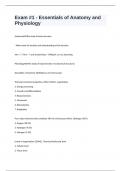Exam #1 - Essentials of Anatomy and
Physiology
AnatomyANSThe study of body structure
- What made of, location and understanding of the function
Ana = ?, Time = ? and anatomizing = ?ANSpart, to cut, dissecting
PhysiologyANSThe study of body function of anatomical structures
Specialties of Anatomy (2)ANSgross and microscopic
The basic functions/properties of life (7)ANS1. organization
2. Energy processing
3. Growth and differentiation
4. Responsiveness
5. Movement
6. Reproduction
7. Adaptation
Four major elements that constitute 96% of cell structure:ANS1. Hydrogen (65%)
2. Oxygen (18.5%)
3. Hydrogen (9.5%)
4. Nitrogen (3.3%)
Levels of organization (5)ANS1. Chemical/molecular level
2. Cellular level
3. Tissue level
,4. Organ level
5. Organ system
Chemical/molecular levelANSatoms combine to molecules
Cellular levelANSsmallest living units in organisms
Tissue levelANSgroups similar cells that perform a function
Organ levelANSDifferent types of tissues that perform a common level
Organ systemANSconsists of different organs that work closely together
11 organ systemsANS1. integumentary
2. skeletal
3. muscular
4. nervous
5. endocrine
6. cardiovascular
7. lymphatic
8. respiratory
9. digestive
10. urinary
11. reproductive (male and female)
integumentary systemANS- Consists of the skin, mucous membranes, hair, and nail
- protects against environmental hazards, sensory information and regulate body temp
skeletal systemANS- Bones, bone marrow, associated ligaments
- Provides protection and support for other tissues, stores calcium, forms blood cells
, muscular systemANS- Consists of skeletal muscles, tendons, and ligaments
- provides movement, connects muscles to bones, attach bones together to form joints, provides
protection and support
nervous systemANS- brain, spinal cord, nerves
- detects the immediate response to stimuli, coordinates activities of other organ system and
provides/interprets sensory info about external conditions
Endocrine systemANS- thyroid gland, pancreas, gonads
- directs long term change in activities of other organ systems, adjust metabolic activity and every
used by body and controls many structural and functional changes during development
cardiovascular systemANS- heart, blood vessels, ventricles
- distribute blood cells, distribute het and assists in the control of body temp and pumps blood in and
out of heart
lymphatic system (immune)ANS- spleen, thymus, lymph node
- defends against infection and disease and returns tissue fluids into the bloodstream
respiratroy systemANS- nasal cavities, sinuses, trachea, lungs
- delivers air to the alveoli, provides oxygen to the bloodstream and removes carbon from lungs and
produces sound for communication
digestive systemANS- teeth, stomach, intestines, liver
- processes and digest food, absorbs and conserves water (large intestine/stomach), absorbs
nutrients (small intestine) and stores energy reserves
urinary systemANS- kidneys, ureters, urinary bladder, urethra
- removes waste product from the blood, controls water balance by regulating the volume of urine
produced and stores urine prior to eliminating it
reproductive system (male)ANS- testes, penis, prostate gland
- produces male sex cells (sperm) and hormones




